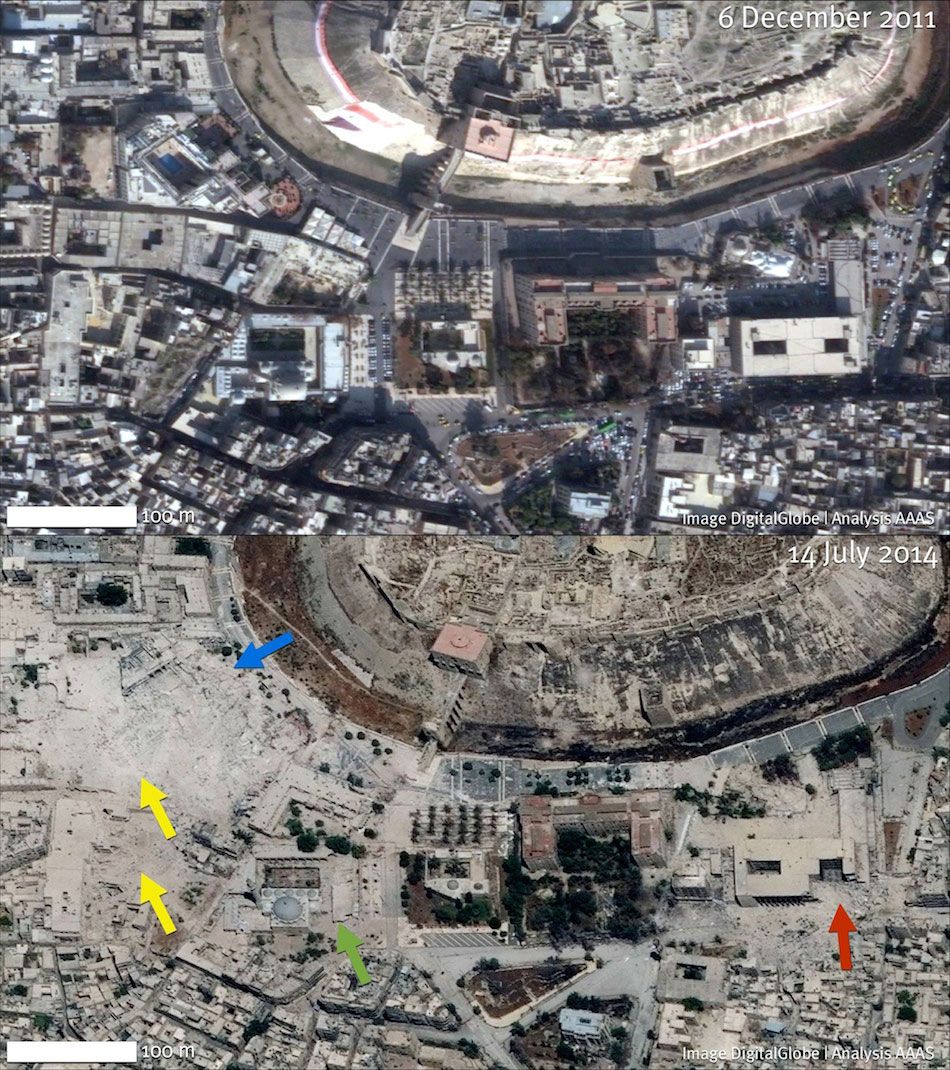War Is Destroying Syria's Ancient Treasures, Satellite Photos Show

Three years of heavy fighting have taken a toll on Syria's archaeological treasures. Five of the country's six World Heritage sites "exhibit significant damage," and some buildings are now "reduced to rubble," according to high-resolution satellite images examined by the nonprofit and nonpartisan American Association for the Advancement of Science (AAAS).
World Heritage sites are rigorously selected by the United Nations Educational, Scientific and Cultural Organization (UNESCO), and must "represent a masterpiece of human creative genius," among other criteria, according to UNESCO's website.
The AAAS' report is the first to offer a thorough look at the damage caused to Syria's heritage sites. [See satellite images of the damage in Syria]
"Only one of Syria's six World Heritage sites — the ancient city of Damascus — appears to remain undamaged in satellite imagery since the onset of civil war in 2011," Susan Wolfinbarger, director of the Geospatial Technologies and Human Rights Project at AAAS, said in a statement. And "the Damascus site also could have damage not visible in satellite images."
Damage to the other five sites is extensive, the AAAS said. These sites include the ancient city of Aleppo, the ancient city of Bosra, the ancient site of Palmyra, a site with two castles (Crac des Chevaliers and Qal'at Salah El-Din), and the ancient villages of northern Syria (Jebel Seman, Jebel Barisha, Jebel Al A'la, Jebel Wastani and Jebel Zawiye.
The analysis showed widespread damage in Aleppo, one of the oldest continuously occupied cities in the world, which dates back to the second millennium B.C.
"In satellite imagery, massive destruction is obvious throughout the city, and especially at the World Heritage site of the ancient city [of Aleppo]," Wolfinbarger said.
Sign up for the Live Science daily newsletter now
Get the world’s most fascinating discoveries delivered straight to your inbox.
A before-and-after analysis from 2011 to 2014 indicates new damage to historic mosques, Koranic schools called madrasas, the Great Mosque of Aleppo, the Souq al-Madina, the Grand Serail of Aleppo, the Hammam Yalbougha an-Nasry, the Khusruwiye Mosque, the Carlton Citadel Hotel, the Khan Qurt Bey caravanserai and other historic buildings south and north of the citadel. [5 Surprising Cultural Facts About Syria]
The Great Mosque has extensive damage. Satellite imagery showed destruction of the roof and a destroyed minaret, or tall spire, as well as two craters on the mosque's eastern wall. Researchers saw the heaviest damage south of the citadel, but the area to the north, which has buildings from the late Mamluk to Ottoman periods (13th to 19th centuries) also showed signs of destruction.
The other World Heritage sites have damage ranging from mortar impacts near an ancient Roman theater in Bosra to newly constructed military compounds on an archaeological site. New roads and mounds of earth are scattered through the Northern Roman Necropolis in Palmyra.
Palmyra sits in a desert just northeast of Damascus. Its ruins combine Greco-Roman art with Persian influences, and UNESCO said it "contains the monumental ruins of a great city that was one of the most important cultural centers of the ancient world."
Another World Heritage site, the Crac des Chevaliers castle, has "moderate structural damage," the AAAS analysis found. The castle, an example of a Crusader stronghold, has a 20-foot-long (6 meters) gash on its southeast tower and crater marks on the ground.
One of northern Syria's ancient villages, the Jebel Barisha Ancient Village Park, shows three new military buildings, including two within the park's boundaries.
"From our contacts and sources in Syria, we knew that there was damage to World Heritage sites," said Brian Daniels, director of research and programs at the Penn Cultural Heritage Center at the University of Pennsylvania Museum of Archaeology and Anthropology. "But this report surprised us by revealing just how extensive the destruction actually is."
The AAAS released the analysis yesterday (Sept. 18), a day before the Smithsonian Institution's meeting to honor the 1954 Hague Convention for the Protection of Cultural Property. Researchers plan to discuss the damage and intervention efforts in Syria at the meeting.
"There is hope, and it lies with our Syrian colleagues because they are the stewards and caretakers of these sites, and they see the value in preserving and protecting them for future generations," said Corine Wegener, cultural heritage preservation officer for the Smithsonian Institution. "What they need from their international colleagues is some help to do that — training, materials and other support in the international arena for the notion that it is possible to mitigate and prevent damage to cultural heritage, even in the midst of conflicts."
The AAAS will continue to assess damage to Syria's archaeological sites, Wolfinbarger said. UNESCO placed all six of Syria's Cultural Heritage on the "List of World Heritage in Danger" in 2013. The Syrian crisis has killed 100,000 people and displaced millions, according to the United Nations.
Follow Laura Geggel on Twitter @LauraGeggel and Google+. Follow Live Science @livescience, Facebook & Google+. Original article on Live Science.

Laura is the archaeology and Life's Little Mysteries editor at Live Science. She also reports on general science, including paleontology. Her work has appeared in The New York Times, Scholastic, Popular Science and Spectrum, a site on autism research. She has won multiple awards from the Society of Professional Journalists and the Washington Newspaper Publishers Association for her reporting at a weekly newspaper near Seattle. Laura holds a bachelor's degree in English literature and psychology from Washington University in St. Louis and a master's degree in science writing from NYU.










